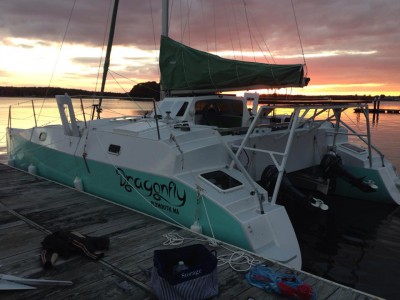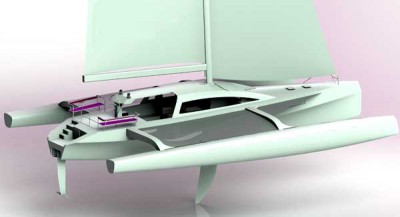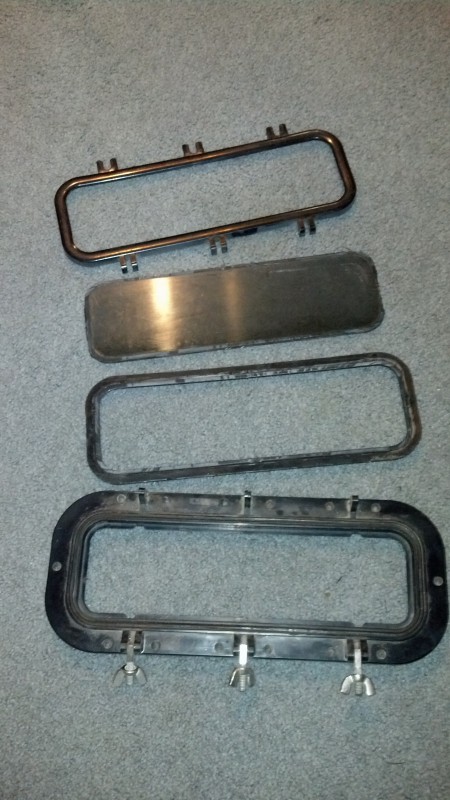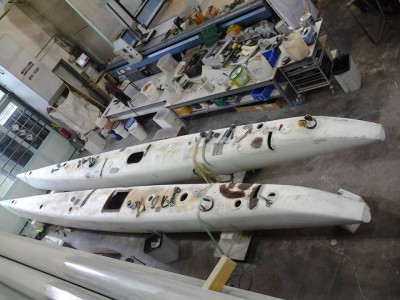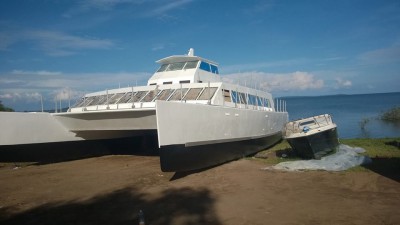Again no website and no email today. Tech claims there were no interruptions yesterday and are looking into today. Waiting for tier 2 tech call back.
Monthly Archives: December 2014
Forward Cockpit 2
And my notes. Not nearly as poetic as Richard’s.
Every so often a catamaran design appears with its helm forward, usually just aft of the mast. The old Searunner trimarans had that configuration also. With a sort of amnesia, observers get quite excited about it as a new design phenomena, every time. And I now hear the phrase “If Gunboat does it, it has to be good.”
It does solve the classical problem of the helm person having to see over or through the house cabin. Beware however the unintended consequences.
There are several. And long ago I learned that just because the famous do something doesn’t make it right. Gunboat also eschews traveler cars and tracks.
Most important, protection from wind and water is almost totally gone. Especially monohull sailors have no idea that a sweet looking cruising cat can do 25 knots on a reach. Subsequently they have no idea how much exploded water will be deluging them at speed. With no protection, even with no waves, it is cold, especially at night.
In a storm, the connection to inside is a door on the front of the cabin. When there is a firehose of white water blasting the front of the cabin, nobody will dare open that door.
On modern cats, the big sailing engine is the mainsail. That is aft of a helm forward. On a traditional helm aft, one can keep an eye on the mainsail trim and still watch where you are going. With helm forward, that will be cricking your neck to keep an eye on the power sail back up behind you.
Related to the mainsail as the power engine is safety. How often does the traveler car or the mainsheet block jam during a tack? If the problem is out of sight and 7 meters behind you, that is a safety problem. More, if a mast fails, or a mast base block explodes, the helm person is right in that impacted area.
On modern, powerful catamarans, being able to release the mainsail in literally an instant in the event of a crisis is critical. Having the entire mainsheet line in clear view and easy access is so important.
In the real world, the benefit of shorter halyard lines, and down low clear view is far outweighed by the exposed and dangerous location of that helm forward.
Forward Cockpit.
I can’t believe I never posted this but the search shows nothing. One of the best articles was in Lat. 38 back in ’03. I quote.
http://www.latitude38.com/letters/200312.htm December ‘03
Ian – If you were to put Chris White, Peter Johnstone, Gino Morrelli, Pete Melvin, Kurt Hughes, and us together in the same room to design a performance cruising catamaran, we think there would be a considerable consensus on the basic issues. The hulls would be longer rather than shorter for inherent speed, and they would have something like a 12 to 1 length to beam ratio so they could still carry a decent load. The cat would have relatively high freeboard so the bridgedeck didn’t repeatedly get ‘bombed’ by waves. Within reason, it would be as light as possible, and what weight there was would be centrally located to reduce pitching. The cat would be a fractionally-rigged sloop with a self-tending Solent jib and a bigger headsail on a sprit on a furler. Beyond these considerations, there would be the usual differences in the amount of beam, the rocker, the shape of the rudders, the look, and the general layout – many of them dictated by the owner’s needs and desires.
Speaking of catamaran layouts, and since you made a big deal of it, we must once again proclaim our total befuddlement with the concept of a ‘front cockpit’. We have the greatest respect for Chris, Peter, Gino, and Pete – all of whom have at least somewhat subscribed to the concept – but we think the idea is as bizarre as if Cher had gone ahead with her threat to relocate her boobs on her back. What’s to recommend either idea?
We’d humbly like to suggest there is only one place for helms on catamarans, that being on each side of the back bulkhead of the salon as – how surprising! – found on Profligate. We feel as certain of this as of anything in life. That way it’s easy to adjust all sail controls without – as in the case of the front cockpit – having to open a door at the front of the salon to go out and get blown about and drenched, in order to do something as minor as adjusting the tension on the main halyard. It might even require putting on foul weather gear!
To show we have no hard feelings toward Peter, Gino, and Pete, one of the most appealing performance cat designs we’ve seen can be found at the Morrelli & Melvin website under Gunboat 52. It’s just a basic sketch, and it’s our understanding that the boat isn’t going into production, but it has all the features we’d be looking for in a custom performance cruising cat. If only somebody could figure out how to build them for an affordable price. Kurt Hughes and Chris White also have extensive websites that are worth visiting to see their designs.
There is an easy explanation for the first Gunboat 62 and the first Atlantic 55 being both named Spirit – it’s a popular boat name. End of story. Unless, of course, you’re into conspiracies.
ttp://www.latitude38.com/letters/200304.htm
April ‘03
Profligate is based on a 60-ft by 30-ft stock design by Kurt Hughes of Seattle, but was stretched three feet and the bridgedeck clearance was increased by six inches. Such a catamaran in the Caribbean would carry about 65 passengers on daytrips, but we never sail with much over 35 people. Adventure Cat, another Kurt Hughes design that is frequently seen on San Francisco Bay, is 55 feet by 30 feet, and she’s Coast Guard licensed to carry 49 passengers. One of the really cool things about cats such as Profligate and Adventure Cat is that, although they can easily carry many people, they are very easy to sail by just one or two people.
Dragonfly Travel Update
Dragonfly now lives in warmer climates. James and Emily in much warmer weather now. I need to have a place on this blog for links to the various voyages of the starships.
http://dragonflysail.blogspot.com/
Server Down
I came in this morning to find both the website and email down. Myservlink has been better than Drizzle was, but it is annoying. I assume they will have it fixed soon.
Rapido 60?
Am I the only one who thinks the heavily buzzed new trimaran Rapido 60 looks like an old style F27 made bigger? Didn’t they just used to copy Tony Grainger? To me it looks like a big big step backwards in styling. If they were still cloning Tony it would look much better. In my opinion. And what does it add that wasn’t done 25 years ago? Besides a cockpit roof. http://multihullblog.com/?s=gs61
Rejuvenating Plastic Ports
Maybe everybody knew this, but I finally sorted out how to get the panes out the the frames on these.
The problem was getting the plastic frame split open to free the crazed acrylic pane. I finally figured out that several laps around the seam with a matt knife does the trick. The exploded window frame shown below.
I need 4 more of these 4″ x 14″ ports if anyone has some to sell. Either color.
Holiday Discount
Been so busy with the projects that I forgot about the annual holiday discount. Any interest in it this year? I think I have been doing that for some 7 years now.
Let me know if anyone was ready to purchase plans.
